SPECIAL SIGNS
The cryptogram from the “Flibustier mystérieux” contains several signs that do not belong to the classic Masonic script. Although they have been known for decades, they have hardly been systematically investigated by researchers – mostly ignored or reinterpreted to support their own theories. In this article, these so-called special characters are analyzed in detail for the first time and placed in a comprehensible context. By comparing a map from 1753, it can be shown that several of these signs correspond strikingly precisely with geographical points on the Île de France (Mauritius). This observation raises new questions about the date of origin of the cryptogram – and fundamentally questions previous attributions to the pirate Olivier Levasseur.
Among the 517 characters of the Masonic script, which E. A. Dresen counted in his book “Die Paragoninsel” (2015), there are 5 that clearly do not belong to the Masonic code:
– The D on the 1st line

– The number 2 on the 2nd line

– The number 2 on the 6th line

– The “stain” on the 15th line

– The “slash” on the 16th line

In addition, there is a double character consisting of the letters S and U on the 14th line (followed by a D in the code) and a conspicuous gap at the beginning of the 6th line.

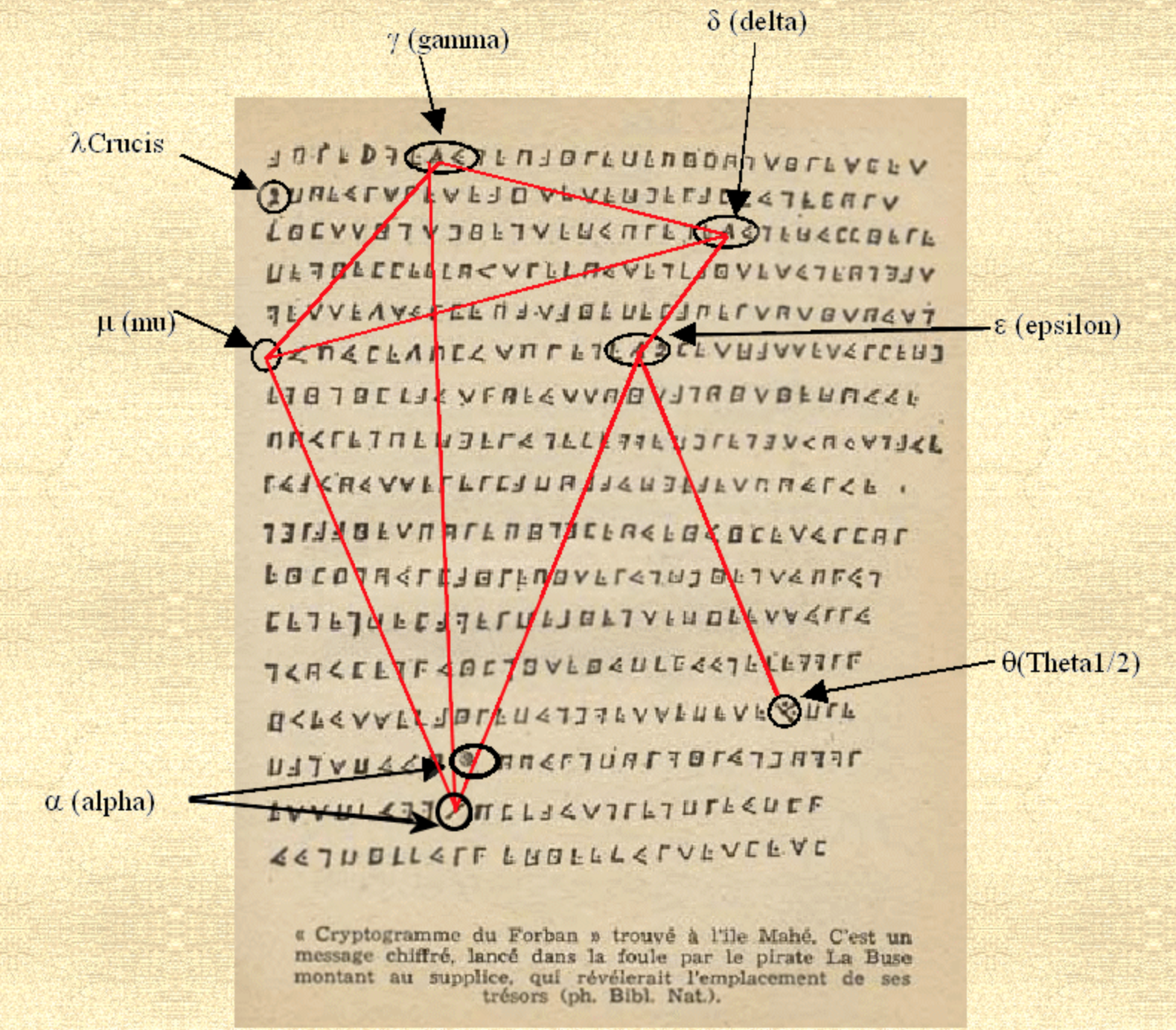
The Southern Cross near Benaben
Anyone who is intensively involved with the cryptogram cannot avoid asking themselves the question of the meaning of these signs. Yannick Benaben constructs a reference to the Southern Cross on his website. Emmanuel Mezino picks out two signs (the SU sign and the slash) and integrates them into his astronomical theory. The slash becomes an X on his version of the cryptogram. Mezino is certain that the treasure is buried there “…I would then say that there is a high probability that the treasure is under the cross of line 16 …”. It is common knowledge: The X marks the spot … For him – as for Benaben and Lougnon – the three Z signs with the dots are also part of his system (on lines 2, 3 and 6, all at the end of the word “prenez”).
Cyrille Lougnon amazes his readers with a precise description of how Olivier Levasseur and his companions went about capturing the location of the treasure on the “Ravine a Malheur”, a 5.6-kilometer-long watercourse in the north of La Réunion on the cryptogram:
“To avoid any possible memory lapses in view of the inevitable changes in the landscape, Olivier Levasseur took the precaution of drawing up a plan of the gorge that would enable him to find the location of the hiding place with certainty when the time came. The piece of canvas depicts a select number of elements of the relief that cannot shift over the years: the large original rock that is now integrated into the structure, the arrangement of boulders and stones that cut off the basalt platform adjacent to the bed of the stream to the east, the rocky outcrop that dominates the terrain to the north, and finally the gap in the escarpment through which they had reached the bed of the stream. To mark these visual markers on his map, and in case he should lose them, Olivier Levasseur resorted to a modified version of the Masonic cipher, a cryptographic art to which he was undoubtedly initiated by a member of the fraternity, except for the central monolith, which is marked there in minute detail.

The rock dam is marked by the symbol /, the spur by [SU] and the embankment line by 3 A [Z-symbol]. The plan thus created was then carefully embedded in lines with similar symbols, leaving a space at the beginning of the 6th line for the main water basin at the bottom of the watercourse to make the whole thing look like a cryptogram. And to perfect the illusion and divert inattentive attention from the index signs, he scrambled an ordinary text long enough to contain all the letters of the alphabet, having previously taken care to remove three letters that occurred with the same frequency as the initial symbols, to respect their frequency signature in the French language, and to randomly swap some others to make it more hermetic.”
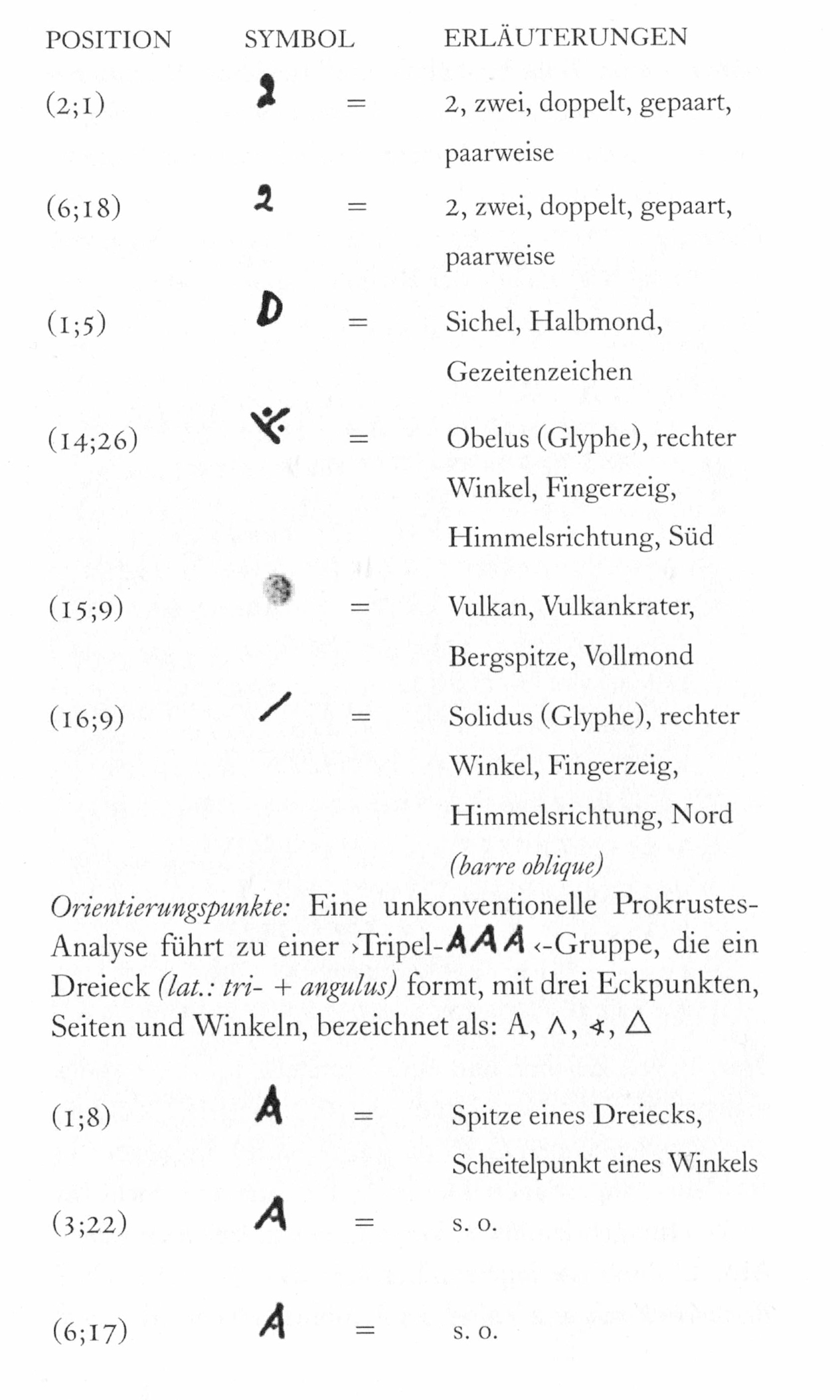
The special signs at Dresen
E. A. Dresen with the special characters (or has a researcher theorize about them in the novel “Paragon Island” ). He gives them names and assigns them a (theoretical) function. He also shows that the SU character with the next character in the cryptogram results in the combination SUD (= south in French). Among other things, he defines the “stain” as a mountain peak. The omission on the 6th line is marked as an “anchorage”. In the course of the plot, Dresen’s protagonist comes across “Paragon Island”, where he recognizes parallels to the content of the cryptogram. In reality, it is the Sychelles island of Frégatte. The hero of the story places the cryptogram over a photo of the island and recognizes similarities with the special characters. An excellent idea!
The “error logic” has shown that many characters of the code within the cryptogram are incorrect for various reasons. It is highly unlikely that the special characters have crept into the text by chance or by mistake. This raises the compelling question of their meaning. The authors waver between an astronomical and a geographical meaning. In principle, nothing can be ruled out from the outset in a riddle, but the theses can be tested. The standards are: Plausibility, probability and sources that can prove a hypothesis.
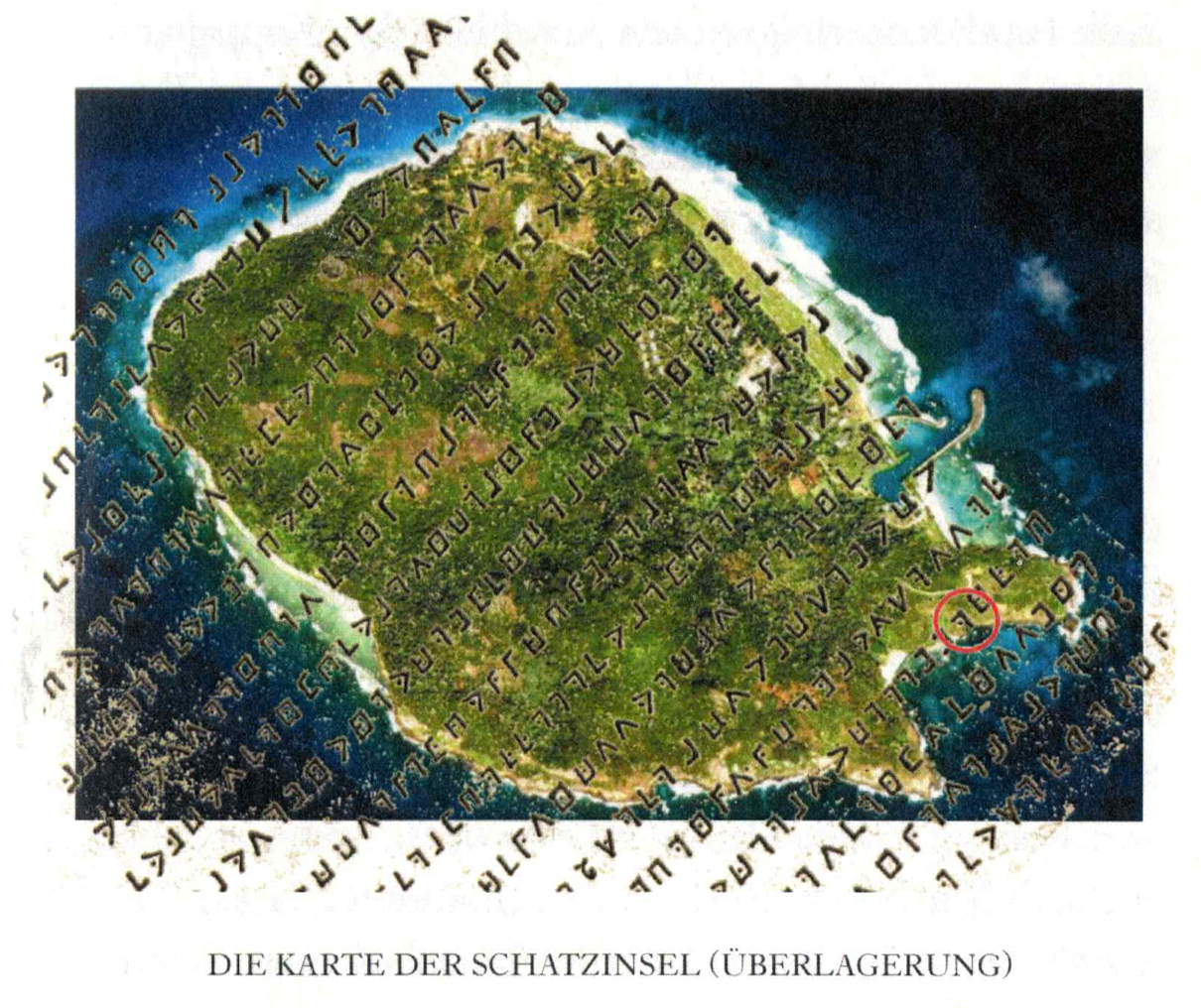
Overlay of the cryptogram with the “Paragon Island” (Île Frégatte)
Dresen’s superimposition of the cryptogram on the island of Frégatte has a glaring weakness: how could the author of the cryptogram have achieved a correspondence between geographical markers and real points in the landscape without adequate map material? The existing maps of the entire Indian Ocean were not drawn according to the principles of modern cartography until well after the middle of the 18th century. Whether Madagascar, the pirate island of Sainte-Marie, the Seychelles or the Mascarene Islands (Mauritius, La Réunion and Rodrigues). None of the maps are suitable for outlining a geographically clear plan. They are no more than a croquis. The attempt to establish any correspondence with maps from the time of La Buse must therefore fail.
When searching for maps, one comes across the following map of the Mascarenes by Rigobert Bonne from 1780.
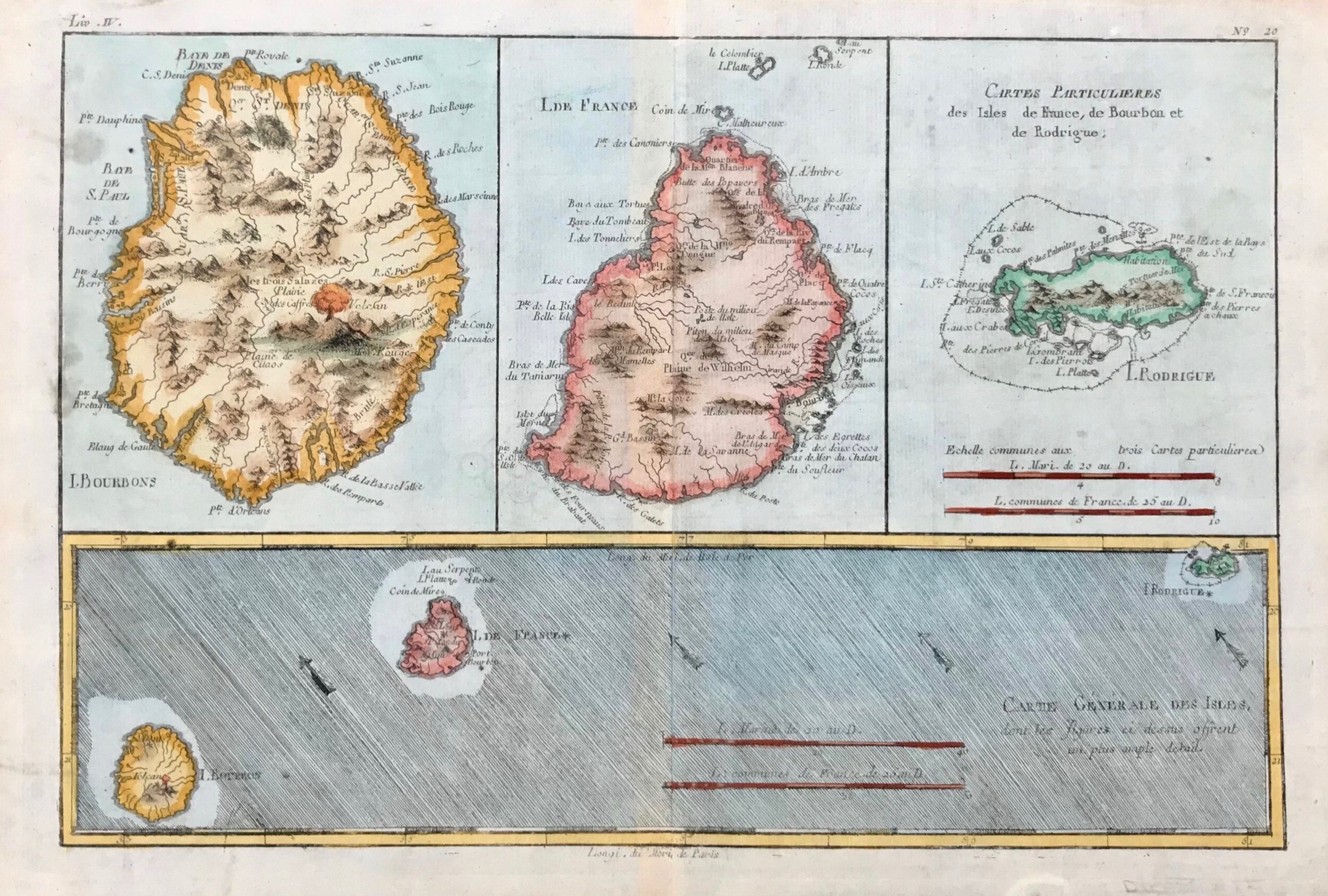
The Mascarenes by Rigobert Bonne (1780)
A brief comparison with today’s proportions shows immediately: Only the island of Mauritius (Île de France) has the correct proportions and corresponds to the actual shape of the island. The model is a map from 1753, drawn by the French astronomer Nicolas Abbé de Lacaille. It is the first precisely measured map of the Indian Ocean! The discovery of this map is the decisive breakthrough on the way to solving the riddle! If you take the cryptogram at the correct magnification and rotate it by exactly -45°, four of the geographical markers assumed by Dresen correspond exactly to the real points on the map:
– The notch on line 6 refers to the port of Mauritius, Port Louis.
– The D on the first line lies exactly on the D of the Piton de la Découverte.
– The “stain” is the highest mountain on the island, the Piton de la Petite Rivière Noir.
– The SU + D sign (= sud) comes to lie exactly on the south coast of the island.
The slash is the 45° rotation marker, the two digits 2 only take on their meaning when you see through the system (see “The map”).
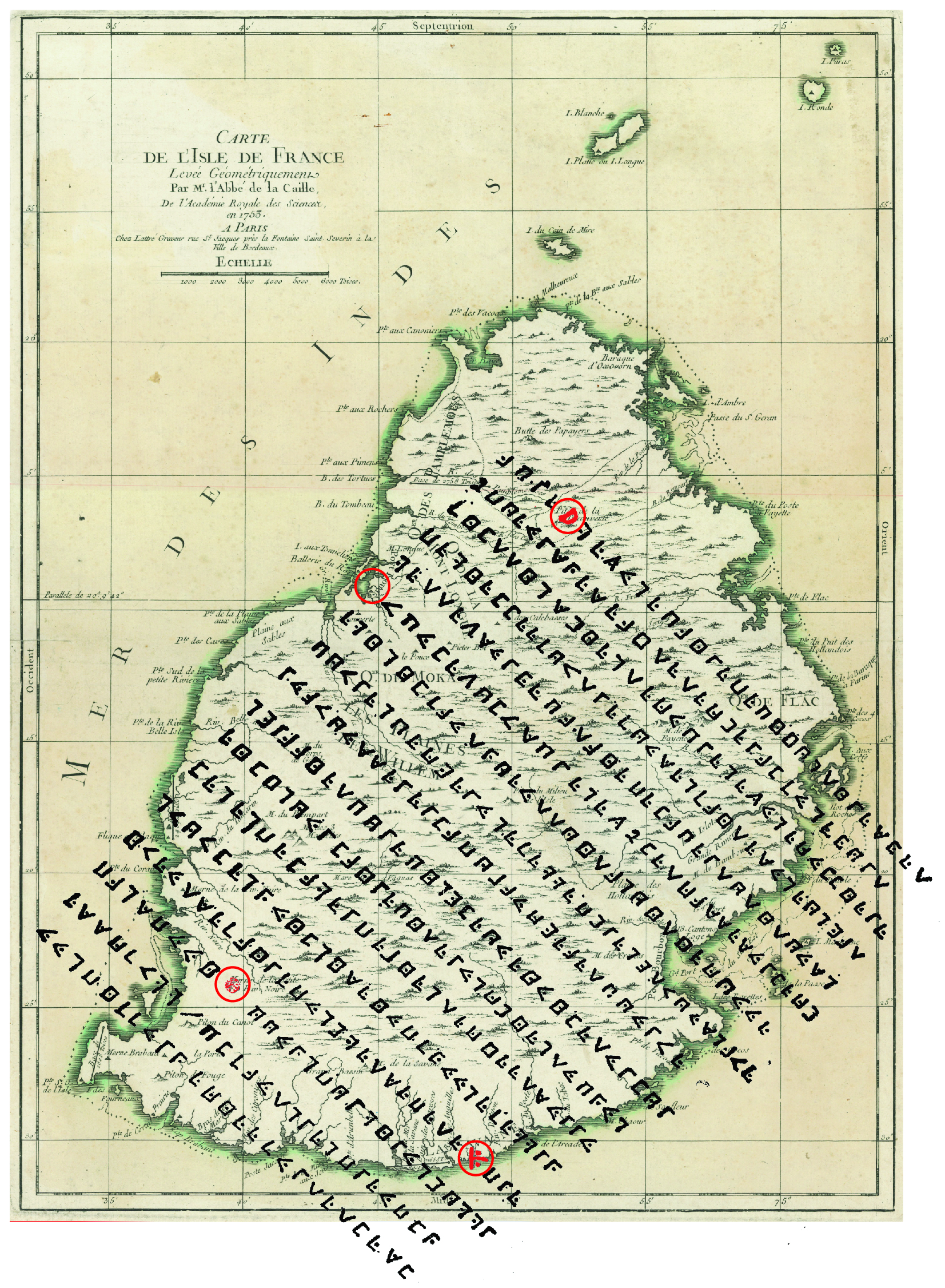
The matches are absolutely amazing, coincidence is out of the question! Anyone who thinks that the cryptogram contains references to geographical locations must go to Mauritius. And anyone who believes that the pirate Olivier Levasseur drew this document must explain how he was able to “synchronize ” it with a map that was only drawn 23 years after his death …
Sources mentioned:
– Dresen, Erik Alexander. The Paragon Island. Ventura Verlag, 2015.
– Mezino, Emmanuel. Mon trésor à qui saura le prendre. 2014.
– Lougnon, Cyrille. Olivier Levasseur dit “La Buse” – Piraterie et contrebande sur la Route des Indes au XVIIIe siècle. Riveneuve, 2023.
– Bonne, Rigobert. Carte générale des isles. 1780.
– Lacaille, Nicolas-Louis de. Plan de l’isle de France tracé sur les Observations géométriques et astronomiques Faites en 1753.
All articles Cryptogram
The cipher that has been sprouting the fantasies of many people in all its aspects for 90 years.
All articles La Buse
The life and work of the most famous French pirate of the 18th century.
All articles Backgrounds
Stories and history about the “Golden Era of Piracy”, La Buse and the cryptogram.
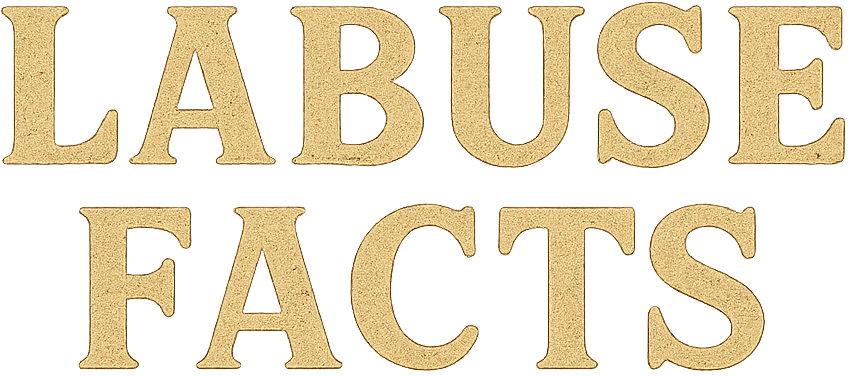
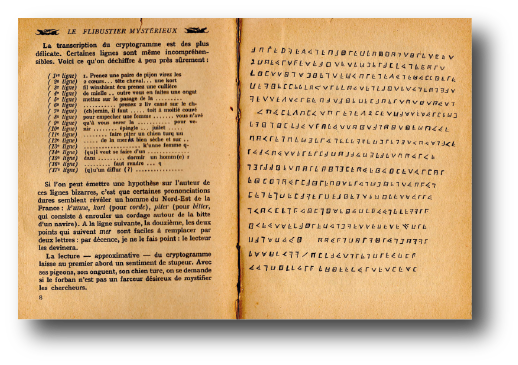

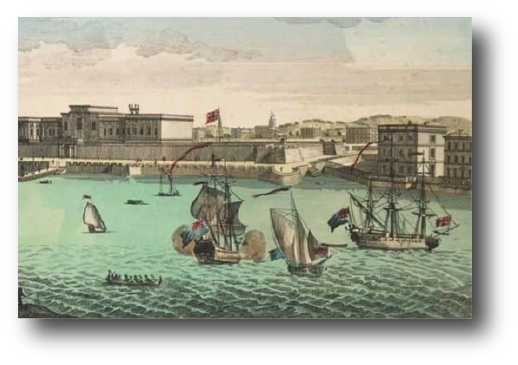


Leave a Reply
Want to join the discussion?Feel free to contribute!